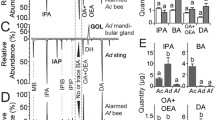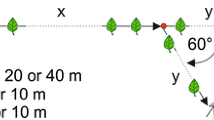Abstract
When the frenzied and irregular food-recruitment dances of bumblebees were first discovered, it was thought that they might represent an evolutionary prototype to the honeybee waggle dance. It later emerged that the primary function of the bumblebee dance was the distribution of an alerting pheromone. Here, we identify the chemical compounds of the bumblebee recruitment pheromone and their behaviour effects. The presence of two monoterpenes and one sesquiterpene (eucalyptol, ocimene and farnesol) in the nest airspace and in the tergal glands increases strongly during foraging. Of these, eucalyptol has the strongest recruitment effect when a bee nest is experimentally exposed to it. Since honeybees use terpenes for marking food sources rather than recruiting foragers inside the nest, this suggests independent evolutionary roots of food recruitment in these two groups of bees.



Similar content being viewed by others
References
Dornhaus A, Brockman A, Chittka L (2003) Bumblebees alert to food with pheromone from tergal gland. J Comp Physiol A 189:47–51
Dornhaus A, Chittka L (1999) Evolutionary origins of bee dances. Nature 401:38
Dornhaus A, Chittka L (2001) Food alert in bumblebees (Bombus terrestris): possible mechanisms and evolutionary implications. Behav Ecol Sociobiol 50:570–576
Free JB, Ferguson AW, Pickett JA (1981) Evaluation of the various components of the Nasonov pheromone used by clustering honeybees. Physiol Entomol 6:263–268
Mena Granero A, Egea González FJ, Garrido Frenich A, Guerra Sanz JM, Martínez Vidal JL (2004) Single step determination of fragrances in Cucurbita flowers by coupling headspace solid-phase microextraction low-pressure gas chromatography–tandem mass spectrometry. J Chromatogr A 1045:173–179
Tautz J, Rohrseitz K (1998) What attracts honeybees to a waggle dancer? J Comp Physiol A 183:661–667
Author information
Authors and Affiliations
Corresponding author
Rights and permissions
About this article
Cite this article
Granero, A.M., Sanz, J.M.G., Gonzalez, F.J.E. et al. Chemical compounds of the foraging recruitment pheromone in bumblebees. Naturwissenschaften 92, 371–374 (2005). https://doi.org/10.1007/s00114-005-0002-0
Received:
Accepted:
Published:
Issue Date:
DOI: https://doi.org/10.1007/s00114-005-0002-0




